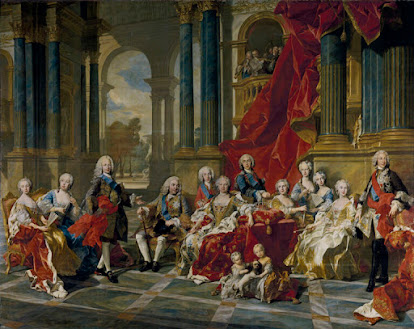Spring is Showing throughout the Italian Renaissance
THE ART
The piece; La Primavera, made by Sando Botticelli was created in Florence, Italy in 1482. It is tempera on wood with the dimensions of approximately 202x314 cm. As Primavera also means 'Spring' it is one of the largest mythological paintings made during the Renaissance era. Sandro was one of the most well-known of the Medici employees. Also believed that he was paid to create it for the marriage of a cousin related to Lorenza the Magnificent Medici. He was very proficient with the use of line work and color.
This piece shows 9 mythological figures surrounding a group of orange trees that were used variously in Botticelli pieces. In the center is the Roman Goddess of love and beauty, Venus with a cupid right above her. To the left is Mercury, the god of the month of May as he is shown with winged sandals as he can lead away the winter clouds. To the right of Mercury is the group, Three Graces. These 3 women represent the feminine attributes like chastity, beauty, love which all correlate with romance. On the right you can see Zephryus who is taking away Chloris. To the left of Chloris is her transformed after marrying Zephyrus into Flora, the Spring goddess.
While there is no definite meaning of the painting to be known, many believe it is a display of 'Springtime Marriage.' The connection of this painting is with the powerful Medici family as their family symbol, coat of arms has orange balls within it. While others also believe the the painting could have the meaning of displaying growth of spring.
Analysis on Primavera
Looking at this piece head on, I am immediately drawn to the middle showing the goddess, Venus. It seems to have 3 parts to this art piece as there is Venus and cupid, Mercury and the Three Graces, and Zephryus and Chloris/Flora. Each tell a different story and all seem to surround Venus in the middle. The figures have different representations but all come together on beauty and love and you can feel it when looking at this piece.
I get a feeling of love, confusion, beauty and strong legend beliefs. As for elements themselves, Botticelli used texture, color, tone and shading, perspective through depth and space. Color, tone and shading is used throughout this painting as the contrasting colors or the dark background highlight the figures. The tone and shading of the figures allows for depth and texture to be seen to actually make out the character to look realistic. The colors also give a sense of emotion like harmony, peace, love and beauty as the colors are contrasting to each other but still remains subtle to keep its beauty. The contrast of the trees in the background allow depth to be shown. They give off the feeling that the figures are all alone and may be scared to be in society as people don't believe in them.
As for texture, depth and space are all done by the colors, placements and line work used. The texture can be shown through their clothes and the nature surrounding them. The clothing varying from sheer dresses to floral dresses, to shawls and to Mercury's sandals all give a sense of texture you can see. Depth and space can be seen through the fact that Venus is center, but in the back to show her importance to the others. The perceptive use of creating depth allows for viewers to feel like Venus has a lot of importance and they may be secluded in a forest.
Connection with Humanism
Humanism was the educational and intellectual program of the Renaissance. Antiquity is what humanism was looking for, for inspiration in rebuilding society. It was a system made through the society but made for the people of those areas. The humanism in the Italian Renaissance was to help introduce the individuality of the people rather than all following a governed belief.
The presence of these mythological figures is found to be a reflection of the humanist interest in the classical world. This concept was very popular in Florence at the time, as he continued with this concept in his paintings. As the Renaissance focused on institutional religion, it became and sought out more themes and beliefs, just like mythology.
The Primavera is a show of humanism through its symbolization of introduction of believing in something other than what was governed at the time. As Sandro painted something that didn't depict the popularity of Christianity in the Italian Renaissance era, his art work became very influential. Everyone thought during that time that there was only one way of believing in God, but this piece was able to show that there is a way of believing in god in various ways. Botticelli was able to connect with humanism and the Italian Renaissance as he drew focus to love, beauty and romance. Using these mythological figures, each represented something that was directly connected with God, giving another method of religion.
My Opinion
I would absolutely love to see this piece in person as it just creates such curiosity. I can imagine myself staring at it for a long time to create a sense of understanding and meaning of the painting. I always had an interest in the mythological beliefs as it is something that not anyone can just think of. As for owning this personally, I wouldn't as it just isn't something that I would want to see everyday.
References:
“Botticelli’s Primavera.” ItalianRenaissance.Org, 2023, www.italianrenaissance.org/a-closer-look-botticellis-primavera/.
Hunt, John M. “Humanism in Renaissance Italy.” Smarthistory, 1 Aug. 2021, smarthistory.org/humanism-renaissance-italy/.
“Renaissance Humanism.” The Art Story, 2024, www.theartstory.org/definition/renaissance-humanism/.
Cycleback, David. “Sandro Botticelli’s Primavera.” David Cycleback, 9 Aug. 2016, davidcycleback.com/2016/08/14/sandro-botticellis-primavera/.
Parenti, Daniela. “Spring by Botticelli.” Uffizi Galleries, 2024, www.uffizi.it/en/artworks/botticelli-spring.
Sommer, Joseph C. “Definition of Humanism.” American Humanist Association, 2024, americanhumanist.org/what-is-humanism/definition-of-humanism/.




Comments
Post a Comment